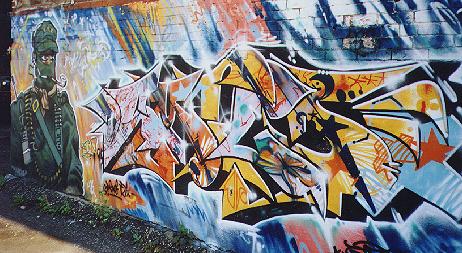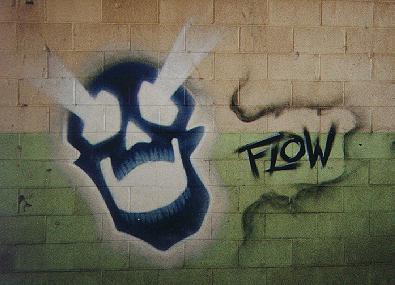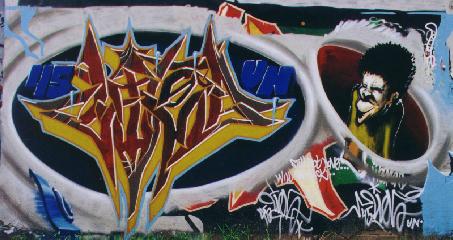|
| 
Graffiti: From Destructive To Constructive
By Rueben Littlejohn
* Reprinted by permission from The Bomb Hip-Hop Magazine Issue # 8
+ Pics used courtesy of the Visual Orgasm web site.
 Graffiti is one of humankind's oldest pastimes. It can be traced to before recorded history. There are caves in rural France where the walls are covered with paintings of bulls, horses and warriors on the hunt. In more recent times, the testimony "Kilroy Was Here" was scrawled on thousands of public places in the U.S. and abroad during World War II, almost to the point of becoming a cliche. Graffiti is one of humankind's oldest pastimes. It can be traced to before recorded history. There are caves in rural France where the walls are covered with paintings of bulls, horses and warriors on the hunt. In more recent times, the testimony "Kilroy Was Here" was scrawled on thousands of public places in the U.S. and abroad during World War II, almost to the point of becoming a cliche.
 Although still scrutinized, this notorious art form has taken on new dimensions of creativity. Today, graffiti has emerged as a art form in it's own right, by showing not only realistic portraits of life in the city, but also complex scenes of fantasy and surrealism. Furthermore, along with hip-hop music, graffiti has evolved as a positive outlet for expression by inner-city youth. Although still scrutinized, this notorious art form has taken on new dimensions of creativity. Today, graffiti has emerged as a art form in it's own right, by showing not only realistic portraits of life in the city, but also complex scenes of fantasy and surrealism. Furthermore, along with hip-hop music, graffiti has evolved as a positive outlet for expression by inner-city youth.
When people say they hate to see graffiti, they are usually referring to the "tags" they see scrawled randomly over public surface. These tags are the nom de plume, the pen name of the graffiti author. In contemporary history, New York City was the first place where graffiti became formerly recognized as an artistic expression.
TAKI 183 is acknowledged as one of the pioneer graffiti authors in New York City. His real name is Demetrius. An immigrant to New York City from Greece, he lived in Washington Heights, a working class neighborhood in northern Manhattan. In 1967, Demetrius saw the name, Julio 204, written on a street near his house. Julio, who lived a couple of blocks, north on 204th Street, wrote his name and street number everywhere he went. Demetrius' nickname was Taki, and he lived on 183rd Street. Hence came Demetrius' tag, TAKI 183. His first tag appeared on the side of a ice cream truck in 1970. Meanwhile, JULIO 204 was jailed for vandalism and thus forced into early retirement. However, Taki, who had a job as a messenger, started getting enormous exposure by writing on the lower east side of New York City. By this time as well, an unspoken graffiti code of ethics had become established. Authors were mysterious figures, who were never to reveal their identity to outsiders(especially parents). They had to be resourceful enough to gain possesion of markers and spray paint to do their work. And courageous enough to run the train tracks of the subway and do other daredevil stunts.
Although writers put their signatures on buses, handball courts, and other locations, the New York City subway system was the primary place where these authors left their mark. They moved from marking the inside of the trains, to the outside, making instant visibility and distinctiveness all important. In 1972, SUPER KOOL 223, completely changed graffiti by spray painting his name in super-wide pink and yellow letters. This took almost an entire can of paint. His creative signature overpowered everyone else's on the train. These gigantic signatures became known as "master pieces." Even though it was still possible to gain respect and recognition by "getting up(getting one's name around)" in different locations, as style became a more important part of the graffiti ethic, it became more prestigious to create original lettering styles. One had to be artistically competent to execute huge "master pieces" on the sides of trains. Lesser graffiti authors began to copy some of the more distinctive authors. These lesser writers were known as "toys."
A writer named TOP CAT moved to New York City from Philadelphia, where a separate graffiti subculture was forming. He painted thin, elongated letters on the sides of subway cars. He called his style the "Philly Style." Later this style became known as the "Broadway Elegant," because various lesser authors on the upper west side of Manhattan would imitate his marks. By this time, most writers were starting to form closely knit groups or "crews." Meetings were held at various spots around New York City. Two of the most famous meeting places at that time were the subway station at 149th Street in the Bronx, and the corner of 188th Street and Audubon Avenue in Harlem.
The "EX-VANDALS" (short for Experienced Vandals) were one of these crews, founded in Brooklyn by Dino Nod. Phase 2 was the president of the Bronx chapter of the EX-VANDALS, but soon broke away and formed "THE INDEPENDENT WRITERS," whose membership included SUPERKOOL 223 and STAY HIGH 149, two of the elite authors of the day. They used the abbreviation "INDS" after their tag to indicate their membership in the crew. Other crews around this time were: MAGIC, INC., THREE YARD BOYS, VANGUARDS, EBONY DUKES, WRITERS CORNER 188, THE MAD BOOMERS, THE DEATH SQUAD REBELS, and THE CRAZY 5 (TC-5). The latter still survives today.
Eventually, someone from the outside had to uncover this underground art form. That someone was Hugo Martinez, a sociology major at the City College of New York. He realized that there was something more to these graffiti signatures than vandalism and with some success was able to refocus the energies of some of the artists to more legitimate means of expressing themselves. In October 1982, Martinez arranged for 12 writers to come to the City College of New York for a graffiti demonstration. He covered a 10 by 14 foot wall with wrapping paper and brought several dozen cans of spray paint. Martinez is quoted in Hagar's book as saying, "They came armed with their own markers, ranging from 1/4 inch 'toy markers' to 2 inch uni-wides. Once they realized the possibilities...(they) created a scene of controlled frenzy." Martinez' efforts turned media attention towards a subculture that was just beginning to spring from the minds and hearts of the New York City youth. He dispelled the myth that graffiti sprang from environments of poverty and deprivation. From his study of the graffiti artists, we learn that a large number of the authors come from working class backgrounds. His analysis of the typical writer's background still holds true today.
Years later, thanks to Hugo Martinez, the city of New York went on to sponsor an annual Graffiti Art Contest. The participants present their murals on large canvas to be judged by a respected panel. The competition is stiff. The winners receive art scholarships to the City College of New York. Many of the contestants have been called upon to paint master pieces in various locations around the city. Since 1967, graffiti has come a long way. It began as incomprehensible and now is an established and accepted art form that is a part of city life. We as a society need to find more places for this art form to be realized as a positive outlet for young people's expression.
 
|
|


